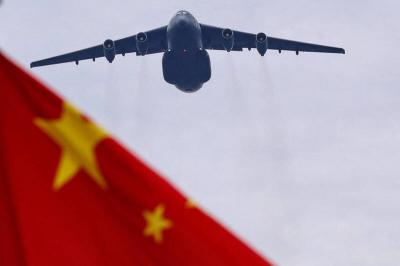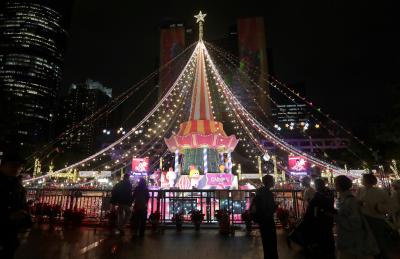Members of the Huang clan on Tuesday celebrated the completion of a decade-long project to renovate their historic estate, the Huang Clan Family Mansion (黃家古厝) in Kaohsiung’s Linyuan District (林園).
Huang Wen-nan (黃文男), president of the Association for the Maintenance of the Huang Clan’s Family Mansion, declared the historic structure open to visitors, saying that the association hopes the mansion would contribute to tourism in Kaohsiung.
About 500 people attended the ceremony as they gathered in the mansion’s rice-threshing ground, which is the second-largest such area in a traditional compound in Taiwan, and performed traditional rituals of tomb-sweeping and ancestor veneration.

Photo: Hung Chen-hung, Taipei Times
The estate, built in 1834 by a branch of the Huang clan known as “the Huangs from Jiangxia with 10,000 households,” (江夏萬戶黃) was listed as a historical site by the Ministry of Culture 10 years ago, and works to repair typhoon and termite damage began the same year.
Budget allocation for the residence’s renovation was divided among the Ministry of Culture, the Kaohsiung City Government and the clan, with the ministry shouldering 70 percent of the costs, the city government 20 percent and the Huangs 10 percent.
The clan, a large and prominent family to which many of Taiwan’s township mayors and county councilors can trace their origins, quickly raised funds by calling on its members for money the traditional method of apportioning each household in accordance to its number of adult males.
Huang Wen-ming (黃文明), eight-term village warden in Fushan (富山) in Taitung’s Beinan Township (卑南), said he brought his family to the event because he felt an urge to visit his father’s childhood home and to connect with his kin.
His recollection of the estate from his childhood is hazy, but he plans on visiting the compound regularly, he added.
Huang Chun-cheng (黃俊成), who was born in the residence, said he donated his mother’s dowry from 80 years ago — a set of antique wooden furniture — to the mansion for display.
“The building’s interior has changed, but the renovated exterior looks precisely as I remember it. It brings back memories,” Huang Chung-cheng said.
Huang Chien-chun (黃健君) said that according to his research, the clan migrated from China in 1737, the second year of Emperor Qianlong’s reign during the Qin Dynasty, and the mansion was built in the traditional layout of typical clan compounds in Zhangzhou in China’s Fujian Province.
The protrusion on the roof known as the “ridged swallowtail” indicates that at least one member of the clan had attained the prestigious rank of Jinshih (進士) in imperial examinations, Huang Chien-chun said.
The 5 hectares of the estate had remained mostly unchanged and the tomb of the fourth-generation patriarch that laid outside the estate is 300 years old, he added.
Some clan members continue to reside in Linyuan, including Huang Chao-cheng (黃兆呈) and Huang Shun-cheng (黃順成), who were respectively a former Linyuan Township mayor and a former Kaohsiung county councilor, from before Kaohsiung’s administrative upgrade.

Beijing could eventually see a full amphibious invasion of Taiwan as the only "prudent" way to bring about unification, the US Department of Defense said in a newly released annual report to Congress. The Pentagon's "Annual Report to Congress: Military and Security Developments Involving the People's Republic of China 2025," was in many ways similar to last year’s report but reorganized the analysis of the options China has to take over Taiwan. Generally, according to the report, Chinese leaders view the People's Liberation Army's (PLA) capabilities for a Taiwan campaign as improving, but they remain uncertain about its readiness to successfully seize

Taiwan is getting a day off on Christmas for the first time in 25 years. The change comes after opposition parties passed a law earlier this year to add or restore five public holidays, including Constitution Day, which falls on today, Dec. 25. The day marks the 1947 adoption of the constitution of the Republic of China, as the government in Taipei is formally known. Back then the Chinese Nationalist Party (KMT) governed China from Nanjing. When the KMT, now an opposition party in Taiwan, passed the legislation on holidays, it said that they would help “commemorate the history of national development.” That

Taiwan has overtaken South Korea this year in per capita income for the first time in 23 years, IMF data showed. Per capita income is a nation’s GDP divided by the total population, used to compare average wealth levels across countries. Taiwan also beat Japan this year on per capita income, after surpassing it for the first time last year, US magazine Newsweek reported yesterday. Across Asia, Taiwan ranked fourth for per capita income at US$37,827 this year due to sustained economic growth, the report said. In the top three spots were Singapore, Macau and Hong Kong, it said. South

Snow fell on Yushan (Jade Mountain, 玉山) yesterday morning as a continental cold air mass sent temperatures below freezing on Taiwan’s tallest peak, the Central Weather Administration (CWA) said. Snowflakes were seen on Yushan’s north peak from 6:28am to 6:38am, but they did not fully cover the ground and no accumulation was recorded, the CWA said. As of 7:42am, the lowest temperature recorded across Taiwan was minus-5.5°C at Yushan’s Fengkou observatory and minus-4.7°C at the Yushan observatory, CWA data showed. On Hehuanshan (合歡山) in Nantou County, a low of 1.3°C was recorded at 6:39pm, when ice pellets fell at Songsyue Lodge (松雪樓), a